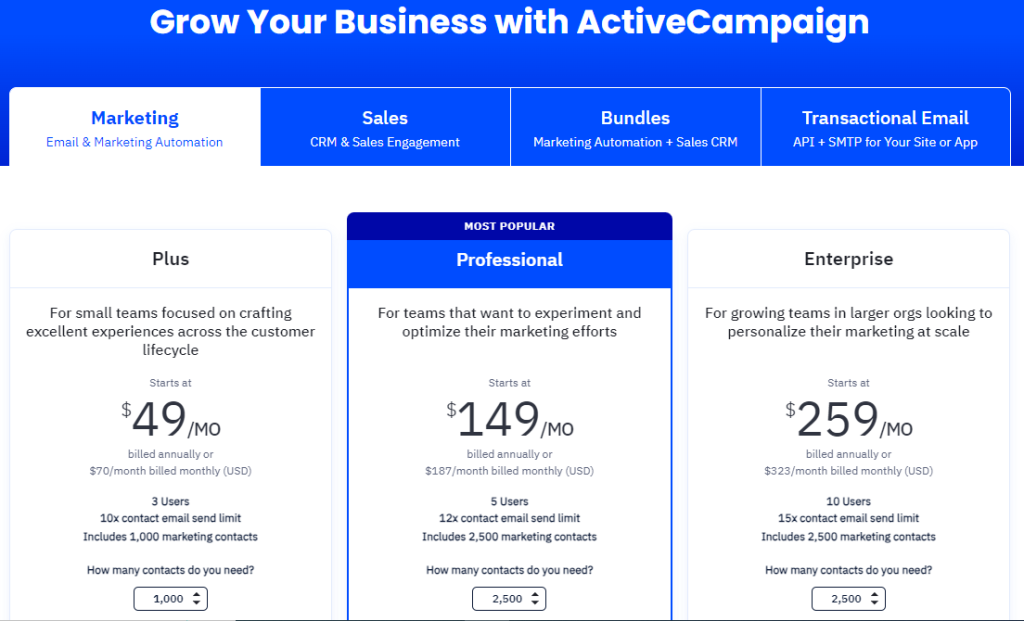Active Campaign Review
Active Campaign is a popular email marketing platform that offers advanced automation, analytics, and CRM features. It helps businesses create incredible customer experiences and drive growth. However, it also has some drawbacks that you should consider before choosing it. Here are some of the pros and cons of Active Campaign:
Pros:
- Active Campaign allows you to send unlimited emails to up to 250,000 contacts with any plan.
- Active Campaign provides detailed and actionable insights into your email performance, such as open rates, click rates, conversions, revenue, and more.
- Active Campaign lets you send text messages to your contacts, either as standalone campaigns or as part of your automation sequences.
Cons:
- Active Campaign does not offer a free plan, unlike some of its competitors.
- Active Campaign’s free trial is very limited, as it only allows you to have 100 contacts and send 100 emails.
- Active Campaign’s email templates are fairly basic in terms of design and customization.
- Unlike some of its competitors, Active Campaign does not have a built-in stock image library.
- Some users have found Active Campaign’s user interface to be confusing, overwhelming, and not very intuitive.
Active Campaign is a versatile platform that combines several essential features for effective marketing and customer relationship management. Here are some of its key features:
- Email Marketing:
- Active Campaign provides robust email marketing capabilities. You can create and send personalised emails, segment your audience, and track performance metrics.
- The drag-and-drop email builder makes it easy to design visually appealing emails.
- Marketing Automation:
- Automation is at the core of Active Campaign. You can set up complex workflows based on user behaviour, triggers, and events.
- Automate follow-up emails, lead nurturing, and personalised communication.
- CRM (Customer Relationship Management):
- Active Campaign includes CRM features to manage customer interactions. You can track leads, organise contacts, and maintain a unified view of your audience.
- The CRM integrates seamlessly with marketing automation, allowing you to nurture leads effectively.
- Personalisation:
- Tailor your messages to individual recipients. Active Campaign allows you to personalise content based on user data, behaviour, and preferences.
- Personalisation improves engagement and conversion rates.
- Site Tracking:
- Monitor user behaviour on your website. Active Campaign tracks website visits, clicks, and interactions.
- Use this data to trigger automation sequences or segment your audience further.
- Landing Pages and Forms:
- Create custom landing pages and forms to capture leads. These can be integrated with your email campaigns and automation workflows.
- Optimise your lead generation efforts.
- Sales CRM & Sales Engagement:
- Manage sales leads, track deals, and collaborate with your sales team within the platform.
- Automate follow-ups, lead scoring, and sales processes.
- E-commerce Integration:
- Active Campaign integrates with popular e-commerce platforms. You can track customer behaviour, send targeted offers, and recover abandoned carts.
- Improve customer retention and drive sales.
Remember that Active Campaign offers different pricing tiers, each with varying features. Here are some key points about Active Campaign:
- Active Campaign allows you to create and manage email campaigns. You can personalise your emails, segment your audience, and track performance metrics.
- With Active Campaign, you can set up automated workflows based on user behaviour. For example, you can send follow-up emails, trigger actions based on specific events, and nurture leads through automated sequences.
- The platform includes CRM features to manage customer interactions, track leads, and maintain a unified view of your contacts. It helps you organise and streamline communication with your audience.
- Active Campaign emphasises personalisation, allowing you to tailor messages and offers to individual recipients. This helps improve engagement and conversion rates.
- Rather than using separate tools for email marketing, automation, and CRM, Active Campaign integrates these functionalities into one platform. This streamlines your marketing efforts and provides a holistic view of your customer interactions.
- Active Campaign offers simple pricing with no setup fees. Active Campaign offers several pricing plans to cater to different business needs.

Here’s an overview of their plans:
- Lite Plan: This plan is suitable for solopreneurs or small businesses. It includes basic email marketing features, automation, and CRM functionality.
- Plus Plan: The Plus plan provides more advanced features, including additional automation options, lead scoring, and SMS marketing.
- Professional Plan: Offers even more features. It includes site messaging, predictive sending, and custom branding.
- Enterprise Plan: This is designed for larger organisations with complex needs. It includes features like custom reporting, dedicated account management, and integrations with other tools.
Conclusion:
Whether you’re a small business or a large enterprise, Active Campaign aims to empower you with the tools needed to enhance customer relationships and drive business growth.
If you’re considering alternatives to Active Campaign, there are several other email marketing and automation platforms available. Here are some noteworthy options:
- Sendinblue: A powerful alternative with similar features to Active Campaign. It offers an easier interface and is often less expensive.
- GetResponse: Known for its excellent email deliverability rates, GetResponse offers features similar to Active Campaign.
- ConvertKit: Designed for bloggers and newsletter creators, ConvertKit offers an intuitive user interface.
- Hubspot: While not exclusively an email marketing tool, Hubspot’s full marketing suite includes email automation, CRM, and more.
Remember that each platform has its unique strengths and pricing structures. Consider your specific needs, budget, and business goals when choosing an alternative to Active Campaign. Explore these options further to find the best fit for your marketing strategy.
Active Campaign is a powerful email marketing platform that offers advanced automation, analytics, and CRM features. It helps businesses create incredible customer experiences and drive growth. To get started with Active Campaign, you can follow these steps:
- Sign up for a free trial: You can sign up for a 14-day free trial of Active Campaign on their website.
- Import your contacts: You can import your existing contacts from various sources, such as CSV files, Gmail, Outlook, or other platforms.
- Create your first email campaign: You can use the drag-and-drop email builder to design your emails or choose from over 125 templates.
- Set up your first automation: You can use the automation builder to create workflows based on user behaviour, triggers, and events. You can automate follow-up emails, lead nurturing, and personalised communication.
- Monitor your results: You can track and measure your email performance, such as open rates, click rates, conversions, revenue, and more. You can also access reports and dashboards to get insights and optimise your campaigns.
In summary, Active Campaign is a powerful email marketing platform that offers advanced automation, analytics, and CRM features. It helps businesses create incredible customer experiences and drive growth.
Active Campaign offers different pricing plans to suit different business needs. You can also sign up for a 14-day free trial to explore the platform and its features. With Active Campaign, you can:
- Send unlimited emails to your contacts with high deliverability rates.
- Create complex and personalised workflows based on user behaviour, triggers, and events.
- Manage customer interactions, track leads, and organise contacts with CRM tools.
- Personalise your messages and offers based on user data, behaviour, and preferences.
- Monitor user behaviour on your website and use it to trigger automation sequences or segment your audience.
- Create custom landing pages and forms to capture leads and integrate them with your email campaigns and automation workflows.
- Manage sales leads, track deals, and collaborate with your sales team within the platform.
- Integrate with popular e-commerce platforms, send targeted offers and recover abandoned carts.
